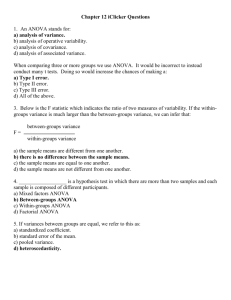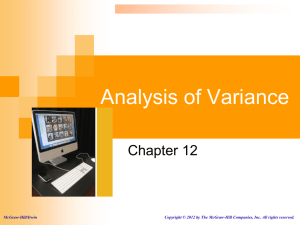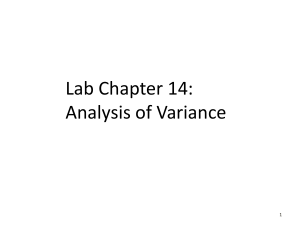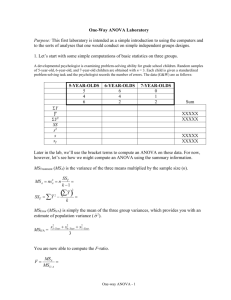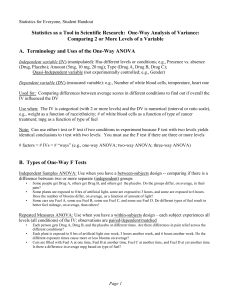Nick Ruiz Methodology and Statistics ANOVA Sample Exam
advertisement
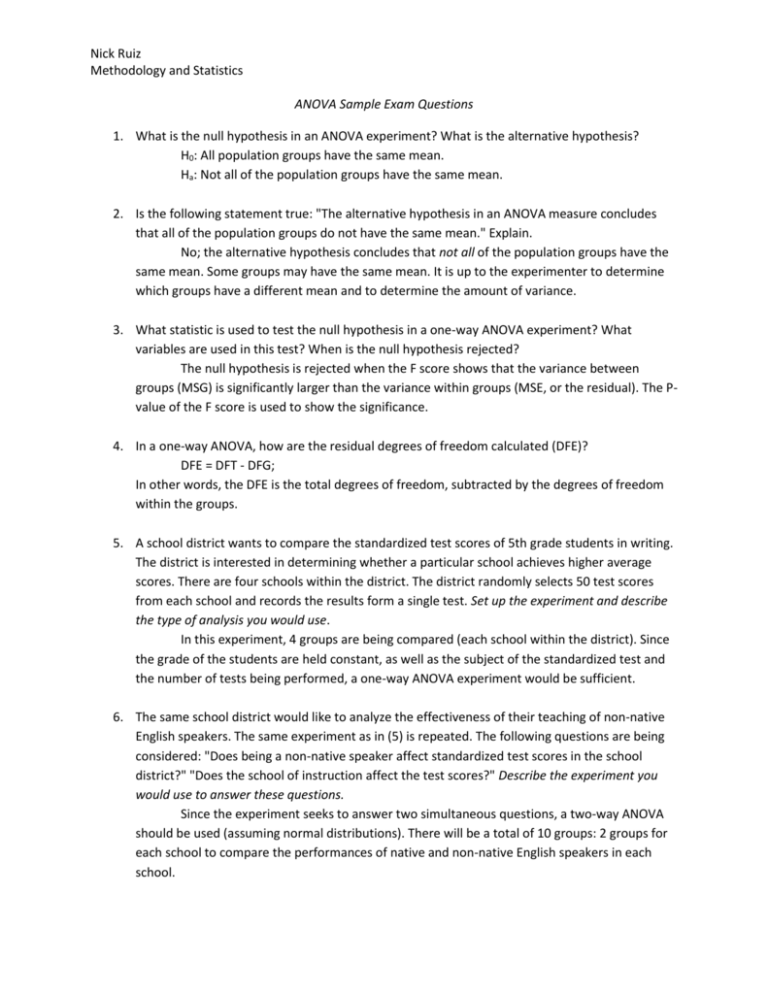
Nick Ruiz Methodology and Statistics ANOVA Sample Exam Questions 1. What is the null hypothesis in an ANOVA experiment? What is the alternative hypothesis? H0: All population groups have the same mean. Ha: Not all of the population groups have the same mean. 2. Is the following statement true: "The alternative hypothesis in an ANOVA measure concludes that all of the population groups do not have the same mean." Explain. No; the alternative hypothesis concludes that not all of the population groups have the same mean. Some groups may have the same mean. It is up to the experimenter to determine which groups have a different mean and to determine the amount of variance. 3. What statistic is used to test the null hypothesis in a one-way ANOVA experiment? What variables are used in this test? When is the null hypothesis rejected? The null hypothesis is rejected when the F score shows that the variance between groups (MSG) is significantly larger than the variance within groups (MSE, or the residual). The Pvalue of the F score is used to show the significance. 4. In a one-way ANOVA, how are the residual degrees of freedom calculated (DFE)? DFE = DFT - DFG; In other words, the DFE is the total degrees of freedom, subtracted by the degrees of freedom within the groups. 5. A school district wants to compare the standardized test scores of 5th grade students in writing. The district is interested in determining whether a particular school achieves higher average scores. There are four schools within the district. The district randomly selects 50 test scores from each school and records the results form a single test. Set up the experiment and describe the type of analysis you would use. In this experiment, 4 groups are being compared (each school within the district). Since the grade of the students are held constant, as well as the subject of the standardized test and the number of tests being performed, a one-way ANOVA experiment would be sufficient. 6. The same school district would like to analyze the effectiveness of their teaching of non-native English speakers. The same experiment as in (5) is repeated. The following questions are being considered: "Does being a non-native speaker affect standardized test scores in the school district?" "Does the school of instruction affect the test scores?" Describe the experiment you would use to answer these questions. Since the experiment seeks to answer two simultaneous questions, a two-way ANOVA should be used (assuming normal distributions). There will be a total of 10 groups: 2 groups for each school to compare the performances of native and non-native English speakers in each school. Nick Ruiz Methodology and Statistics 7. How does the calculation of the total sum of squares differ in a 2-way ANOVA? In ANOVA, the total sum of squares is calculated by: SST = SSG + SSE. In two-way ANOVA, one must account for the variance within each group, as well as the variance when the groups are combined. Thus, SSG = SSA + SSB + SSAxB. 8. What are some advantages of using factorial ANOVA over n one-way ANOVAs? It is more efficient to study the n factors simultaneously, rather than separately. We reduce the residual error in our model by including additional factors to influence the response. We can investigate interactions between the factors. 9. The same school district as in (6) would like to determine how adding additional educational resources for non-native English speakers will improve their writing skills over time. Suggest how the experiment in (6) can be modified to do a longitudinal study. How would you analyze the test results? A repeated measures two-way ANOVA would be used to analyze the results. 10. Assuming that the test in (9) will be performed over 3 years, what are some disadvantages to the repeated measure design that can affect the validity of this test? Students may leave the school district before the analysis is complete, causing the number of test subjects to vary between each group. New students may enter the district during the testing process. Other outside conditions can affect a student's performance/response over time. 11. How is the residual calculation different in a one-way repeated measures ANOVA from a classic one-way ANOVA? In standard 1-way ANOVA: SST = SSG + SSE In repeated measures 1-way ANOVA: SST = SSG + (SSE - SSS) The residual variance decreases in a repeated measures ANOVA, as the sum of squares within subjects is considered.




